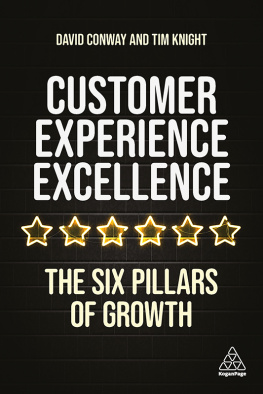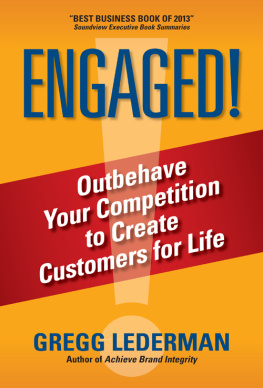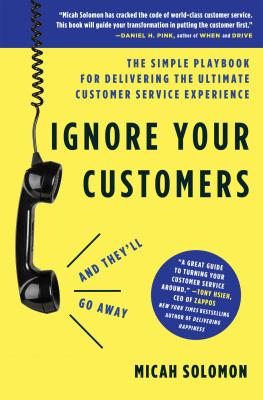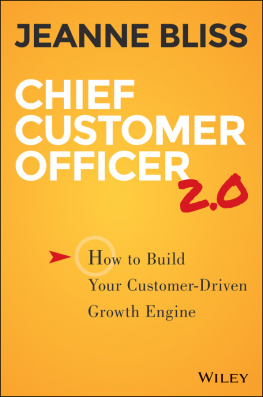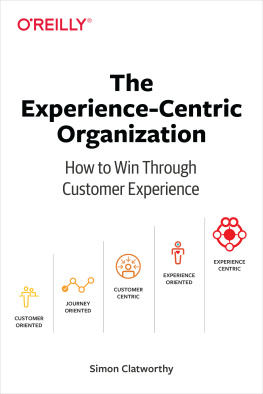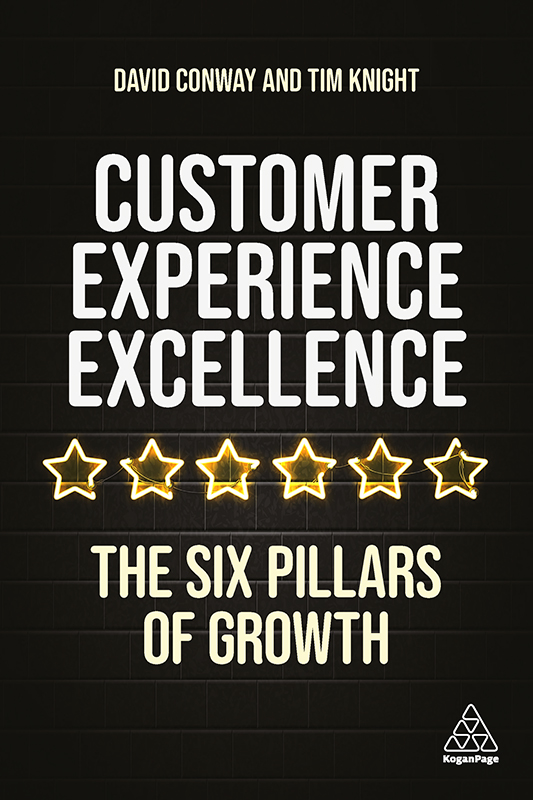
Contents
Landmarks
List of Figures
List of Tables
Page List
Customer Experience Excellence
Contents
LIST OF FIGURES
LIST OF TABLES
Every day, each of us awakes with an objective, a mission, a raison dtre and a purpose. Each of us wants to accomplish something. Small. Large. Whimsical. Relevant. Lasting. Passing. Rudimentary. Life changing. Memorable. Equally on our journey, we are a customer, a consumer or business oriented, an employee, a citizen, a colleague and always we are human.
We also know how those who treat us well make us feel. We know what a good experience feels like and we want to engage with those who make an experience worthwhile. This applies to all who partake in the experience. Those who deliver it. Those who receive it.
Most of us can recall and recount a story of an outstanding experience and a dreadful experience. It is through our tone, volume and emotion that we make it clear where we will spend our precious time, resources and energy in the future and where we will not. In our digital world this perspective is amplified.
Senior executives, management and employees around the world profess to want to deliver a great experience to attract and retain customers in order to propel growth. Every morning, thousands of employees at companies around the world go to work with the goal of serving customers. Most have the desire to do a great job, connect emotionally and create great experiences for their customers. For the fortunate few this is an energizing, human and life-enhancing remit. For many, though, it is just another day of frustration as they grapple with outdated processes, disconnected systems and broken cultures.
Every month, business leaders worldwide study their accounts and forecasts, looking for evidence of high growth and profit. However, many are frustrated when their carefully wrought strategies, tactics, investments and passion fail to deliver. Many tend to look towards technology to help them change the trajectory, yet they continue to struggle to transform and serve the market in a manner that delivers profitable and meaningful customer experiences.
This need not be so. The path to excellence is evolving, but there are key milestones and guides that can help us on the journey. While each companys journey is its own, there are lessons from former leaders that can help. It is a path that any willing organization can study and adopt. This book is about that approach.
My colleagues David and Tim co-founded the Customer Experience Excellence Centre (CEEC) out of the UK in 2010, seeking to quantify and codify what it takes to be a leader in delivering great customer experiences and generating strong outcomes for the business, for customers, for employees and for shareholders. When we started working together, I was immediately struck by the simplicity and relevance of the Six Pillars. These Six Pillars helped articulate how to navigate the ever-changing experiential requirements of the marketplace.
Working together, we chose to extend the work worldwide. Initially this involved reports in countries such as Australia, the USA and the UK. More recently, we have expanded to 34 markets, examining over 3,500 brands. The work tells us who leads, how they do it and how their principles can be applied to the business challenges each of us is struggling with.
Using this and other source material, the authors have captured their learning into a single volume. Its about a better, more human and more connected way to grow businesses.
As such, it is not just a beacon of hope for companies striving to achieve excellence, but a guide to help your business move forward. It outlines a sequential process through which better customer, employee and marketplace engagement is the outcome. The lessons are based on the culmination of millions of customer data points, financial analysis and hundreds of interviews with business leaders.
I believe this material should be essential reading for anyone who wants to engage with the marketplace, be they customers, employees, students, shareholders, regulators or suppliers. Have a read, walk in each of these individuals shoes and contemplate the guideposts to consider.
The good news is that you can benefit from the knowledge of leaders who preceded you. The bad news is that there is no silver bullet. Despite the promises of customer gurus and technologists, no single factor guarantees success. Indeed, the pathway is multifaceted and requires organizations to multitask in a cohesive and integrated way. It requires an appreciation of ever-changing market demand from consumers, employees and stakeholders. It also requires the hard work of understanding that execution needs to be done in a way that is informed, managed, connected and aligned, where each element is mutually self-reinforcing. It demands a new type of leadership.
It may seem a tall order but in every country there is an elite set of companies that have demonstrated the science and art of excellence. At the heart of this is a human, emotional connection, enabling better experiences for customers, colleagues and, consequently, shareholders.
In uncertain and volatile times, Id argue that these lessons on business and human excellence have never been more important.
Julio Hernandez
Global Customer COE Lead
US Customer Advisory Practice Lead
KPMG in the US
This book would not be possible without the kind support of KPMG, whose published research on customer excellence and the Six Pillars has been referenced throughout. In particular we would like to thank Dan Thomas and David Rowlands from the UK partnership, and also Julio Hernandez, who leads the Customer Centre of Excellence globally for KPMG, for their encouragement and support.
We would also like to thank the amazing people of KPMG who have embedded the Six Pillars in their consulting and digital transformation work worldwide. They have helped innumerable organizations to put customer best practice at the heart of sustainable business. It has been the privilege of our careers to work alongside each of you.
Were grateful of KPMGs permission to reproduce its Six Pillar concepts within this work and to reference other published thought leadership on the future of enterprise (`Connected Enterprise) and the changing consumer (`Me, My Life and My Wallet). For Connected Enterprise, we are especially indebted to Miriam Hernandez-Kakol, Julio Hernandez, Duncan Avis and Adrian Clamp. For Me, My Life and My Wallet, Coleen Drummond, Eliza Radford, Jennifer Linardos, Urvashi Roe, Julio Hernandez and Willy Kruh provided further inspirational content. Thanks also to Georgina Severs, who has been a constant source of encouragement and great ideas.
We would like to recognize the contribution of Chris Pitt, CEO of first direct, and David Duffy, CEO of Virgin Money, who were generous with their time and their wisdom and without whom the book would have been considerably the poorer.
Well be forever grateful to Jo Tait, who has contributed enormously to the articulation and the expression of our ideas and has brought rigour to our thinking.
At Kogan Page, Stephen Dunnell has provided great insight and recommendations on how the book could be improved and refined.
This book has been the labour of love over many weekends and evenings, alongside our day jobs. Thanks to our families for giving us the space and understanding to make this possible.
Finally, there is one person who has taken the Six Pillars from a good idea to a global think tank, now supporting business leaders in 34 countries. Tamsin Jenkins, who leads this, has been the mainstay of its work for over a decade and, without her, it would have remained merely a good idea. Thank you, Tamsin.
Next page
